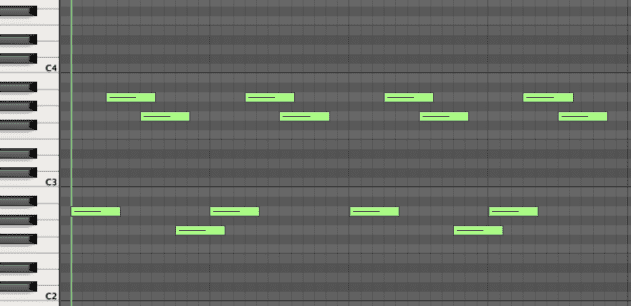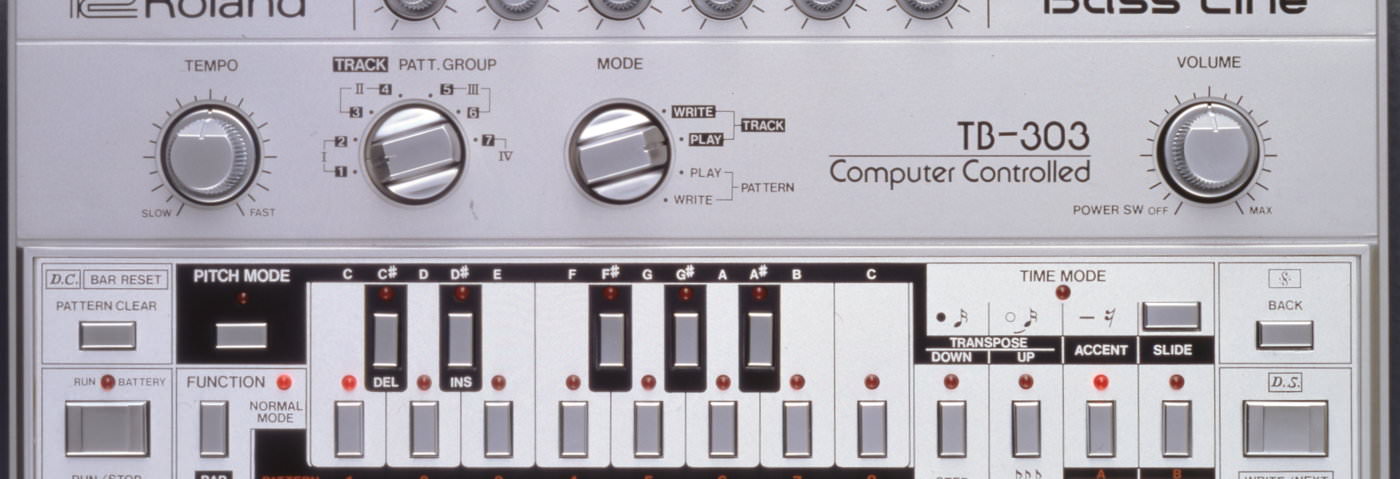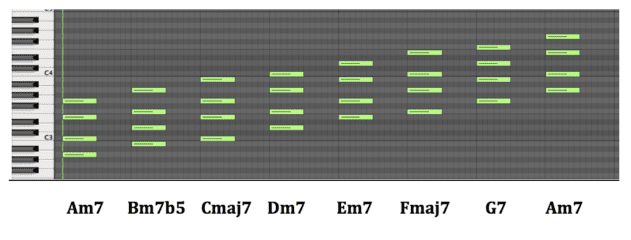Putting theory into practice
Let’s look at this in the context of some slightly pedantic but nonetheless useful theory:
Let’s start with a simple acid-style riff using just the notes A and G:

In this case the ostinato is in A minor. On a theoretical level, the G is the minor 7th of A, rather than the major 7th which would be G#.
As with nearly all aspects of music there are no hard and fast rules concerning what fits together harmonically, but it’s generally safe to assume that chords built using notes from a particular scale will fit nicely under a melody in that same key.
If we go up a minor scale in 7th chords (ie starting with the root minor 7, then raising the root, 3rd, 5th and 7th of the chord one note up the scale each time) we can work out the ‘safest’ chords available to us for putting under this ostinato.
If you happen to be using an ostinato in a major key, it’s convenient to note that all minor keys have a ‘relative major’ key (and vice versa), which uses all the same notes. The 3rd note of a minor key tells you its relative major, the 6th note of a major its relative minor. Therefore, you can start the same progression above at its 3rd interval, C major 7, to see all the chords available in A minor’s relative major scale, C major.
The chords we have available for our A minor ostinato (if we’re playing it safe!) are A minor 7, B minor 7 flat 5, C major 7, D minor 7, E minor 7, F major 7, G dominant 7 and finally A minor 7 at the top again.
They sound like this:
While these chords’ names might not be so important to us, the chords should fit nicely under the ostinato, and we can play some of them underneath to start building our track. Here, we’re using a chord progression of Am7, Em7, Fmaj7, Dm7:
The applications of ostinatos are limitless, from trance riffs to dubstep melodies via 303 acid lines. Depending on its subtlety or complexity, a simple repeating ostinato can help with anything from ‘gluing’ an arrangement together structurally to just giving a crowd something to point their fingers to.


08.36 AM
Wow great post. This is something I have intuitively understood, and even used, but to see that there is solid theory behind it is enlightening. It’s great that you have taken the time to distill this in a way that is useful to those of use left to blindly strike out in the dark, armed only with our intuitive sense of music. 🙂
Great series! I will be posting this article in several places. 🙂
10.33 AM
“The lack of a major or minor 3rd in this particular ostinato means that it could just as easily fit over an A major 7 chord, as we can hear below:”
Why is that exactly? Is that because of the third is the strongest note in a chord?
04.04 PM
Hey Niels,
You’re right, it is usually the third and its interaction with other notes that gives a chord the majority of its ‘character’, and in this sense the third could be said to be the strongest, or most descriptive interval of the scale.
Another explanation for this particular case would be that the root note and the 5th note of a scale are the same notes regardless of whether the scale is major or minor, so this particular riff will fit over chords in an A major or A minor scale.
Using a major or minor 3rd in the ostinato might add to its character and melody, but could also limit the number of chords over which it will fit.
Cheers,
Oliver
10.23 AM
Hi Oliver,
Thanks for the explanation and taking your time . The logic behind it is important for me to know why I do this and when etc.
Niels
04.09 PM
so this is some powerful shit here. was waiting for a mag like this so long. more of this stuff you guys rock! for sure
many greetz
10.28 PM
Wow, this is a great explanation. The ostinato used in the acidlike example is derived from the chord based on the first note of a scale (whether it’s major or minor). Are there other ways to ‘calculate’ a fitting astinato to a certain scale?
02.53 PM
Loved this feature, thank you!
06.53 AM
Update Required? The youtube videos are fine but right below the, play, pause, etc… commands it says, “To play the media you will need to either update your browser to a recent version or update your Flash plugin.” I have the latest version of Google Chrome, I also just downloaded and installed the latest Flash Plugin for the heck of it and I’m still getting the error. Same thing from the latest version of Safari.
10.06 AM
Discohead – sorry to hear you’re having problems with the audio players. We’ve emailed you to try and resolve it.
12.06 PM
Recently discovered this online magazine and I’m loving these articles! The connivence of the music players and the pictures is great.
12.50 PM
thanks for all those great tutorials! i wouldn’t miss it…
02.21 PM
Thank you so much for this! I have picked up this theory blindly I guess by experimentation but to have it explained like this is invaluable for people just starting out and possibly making the transition from DJ’ing into the studio like myself.
08.29 PM
wowo one of the best sites on dance music i have found… newbie to music but this is helping 🙂